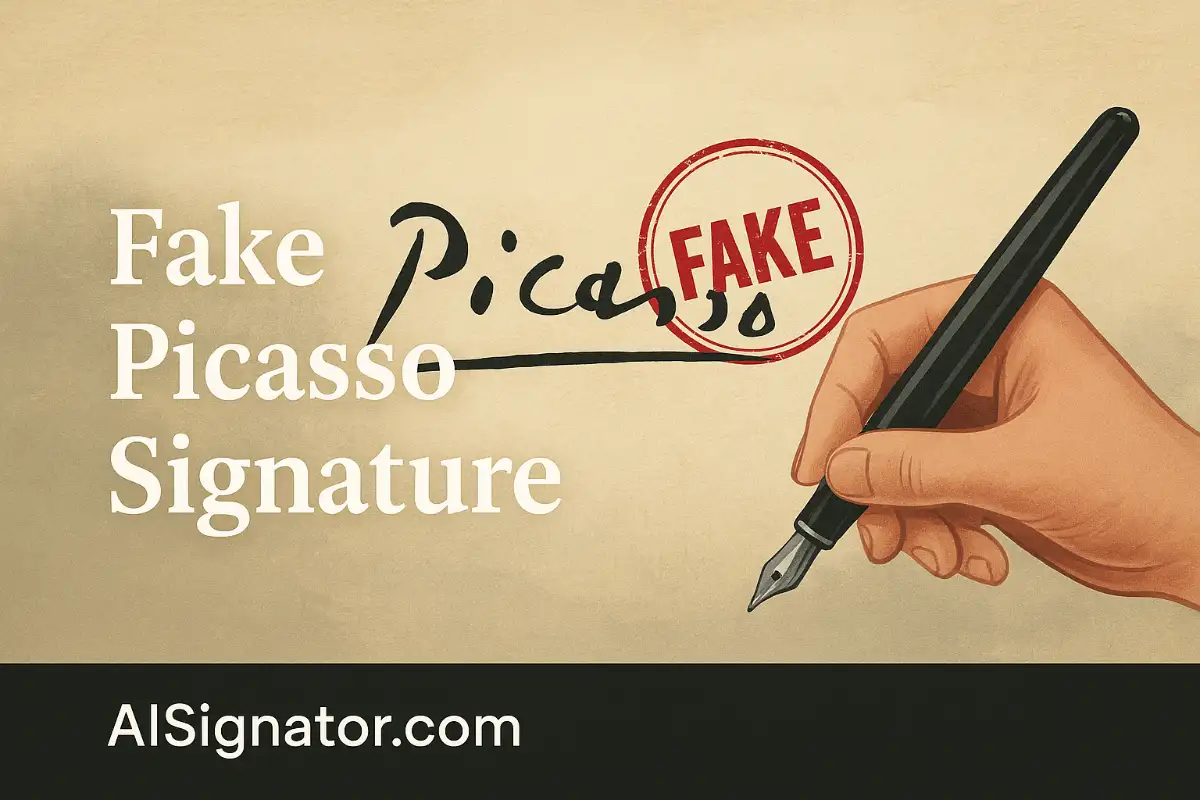🧾 Introduction
Pablo Picasso, one of the greatest and most prolific artists of the 20th century, produced over 147,000 pieces of art in his lifetime. From revolutionary paintings to sculptures and prints, his work holds immense cultural and financial value. With such astronomical worth attached to his name, it’s no surprise that Picasso is one of the most commonly forged artists in the world.
One of the easiest ways fraudsters attempt to deceive buyers is by adding a fake Picasso signature to artworks and prints—turning an otherwise ordinary piece into a high-value collectible. For collectors, investors, and even casual art lovers, understanding how to distinguish a genuine Picasso autograph from a forgery is essential to avoid costly mistakes.
In this article, we will dive deep into how to identify fake Picasso signatures, show side-by-side comparisons, and give you expert tips on verifying authenticity.
🔎 What Is a Fake Picasso Signature?
A fake Picasso signature is any fraudulent attempt to mimic Pablo Picasso’s handwriting on artwork, prints, ceramics, or documents to inflate their perceived value. These fakes can appear in various forms:
- Full forgeries where both the artwork and signature are fake.
- Genuine Picasso prints or ceramics with a forged signature added later.
- Mechanical reproductions of his signature (like stamped or printed signatures) misrepresented as original.
Unfortunately, the art market—especially in the mid-20th century—was rife with limited oversight, allowing many fake signatures to slip into circulation.
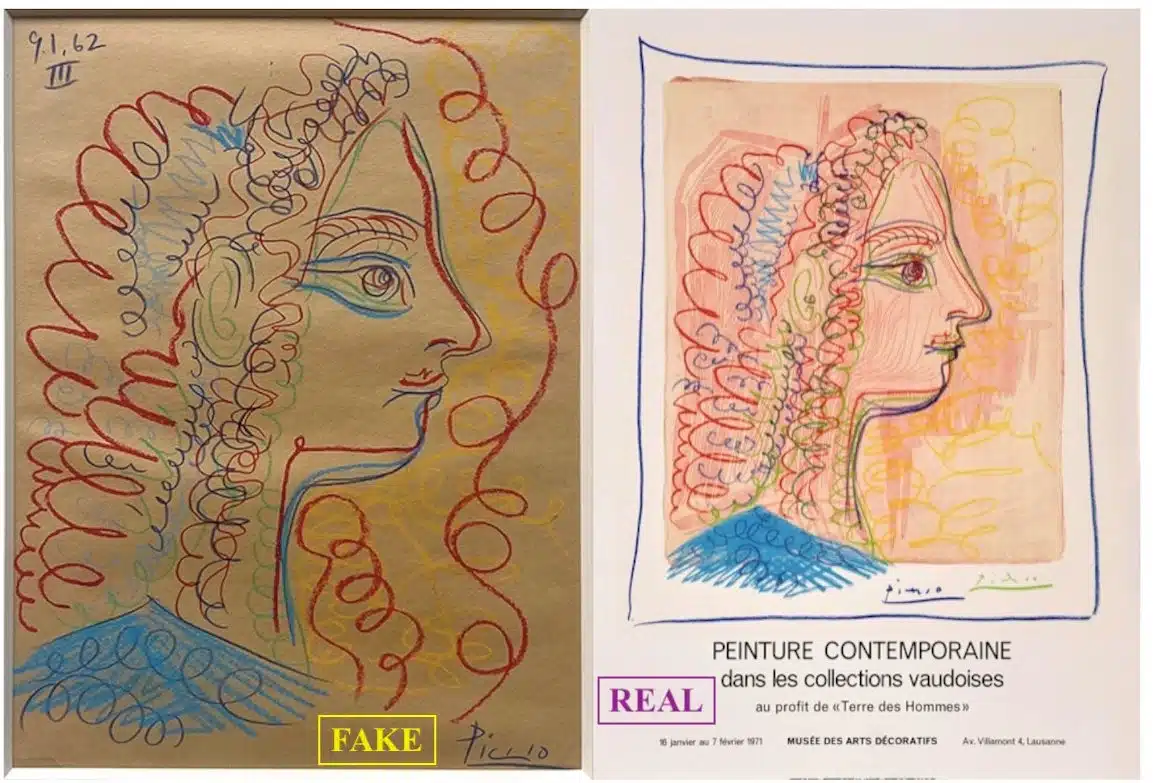
✍️ Real vs. Fake Picasso Signature: Key Differences
Picasso real signature
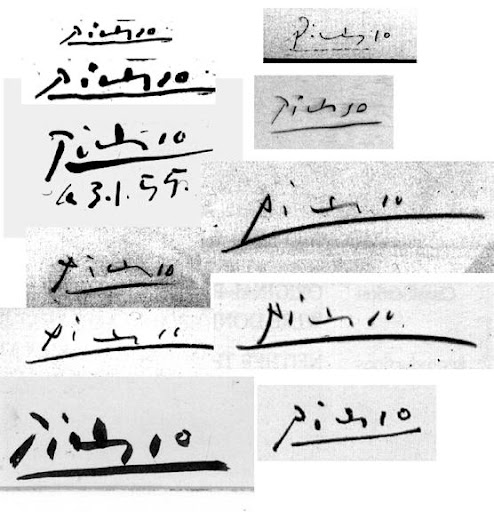
📏 Style and Lettering
Picasso’s signature evolved over decades but had a consistent essence. Key characteristics:
- Early works (1900–1920s): Often signed as “P. Ruiz Picasso,” reflecting his full Spanish name.
- Mature period (1930s–1960s): Mostly signed simply as “Picasso,” written in a distinctive, free-flowing script with slightly irregular letterforms.
Spotting fakes:
- Forgeries often have too-perfect, mechanical letters or inconsistent handwriting style compared to Picasso’s known samples.
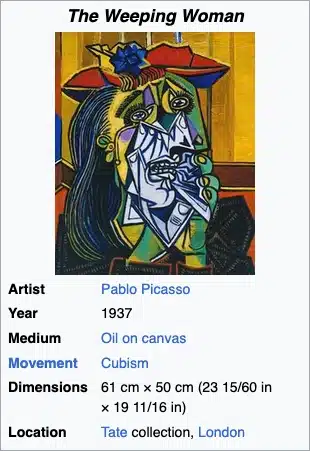
🖋 Stroke and Pressure
A tell-tale sign of an authentic signature is natural pen pressure:
- Picasso’s real signatures show variation in thickness and ink flow, indicating natural hand motion.
- Fake signatures may look flat or uniform, especially if traced or stamped.
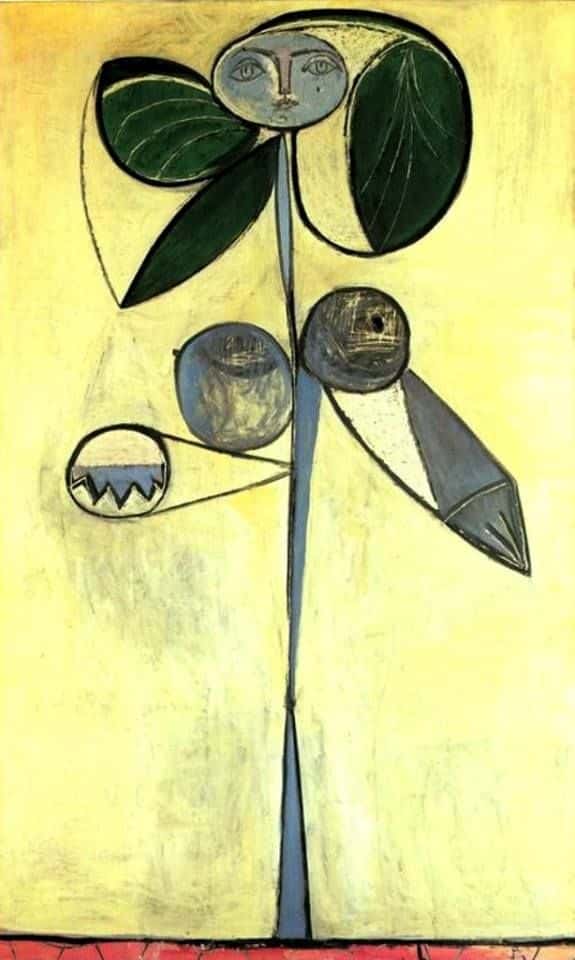
📅 Provenance and Documentation
Picasso’s authentic artworks are usually accompanied by:
- Certificates of authenticity (COA)
- Detailed provenance (history of ownership)
- Listings in official catalogues raisonnés.
Warning sign: If a piece lacks proper documentation, its authenticity should be seriously questioned.
Curious how famous artists signed their masterpieces? Explore the fascinating world of painter signatures and uncover what makes each one unique.
🖼️ Authentic Picasso Signature Samples
Studying verified signatures is critical. Here are iconic works with well-documented signatures:
1️⃣ “Guernica” (1937) – Signed on sketches and lithographs.
2️⃣ “La Femme Fleur” (1946) – Bold, confident strokes.
3️⃣ “Dove of Peace” (1949) – Simple, clean signature.
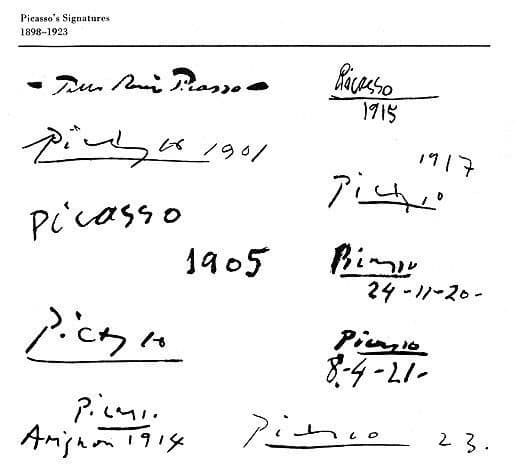
🚨 Signs of a Forged Picasso Signature
Keep an eye out for these red flags:
- ✏️ Even, mechanical strokes (suggesting tracing or printing).
- ✏️ Out-of-place signatures (e.g., weird locations on the artwork).
- ✏️ Mismatched materials (modern ink on an older artwork).
- ✏️ Suspiciously large or small signatures compared to Picasso’s norms.
- ✏️ Obvious inconsistencies with known authentic samples.
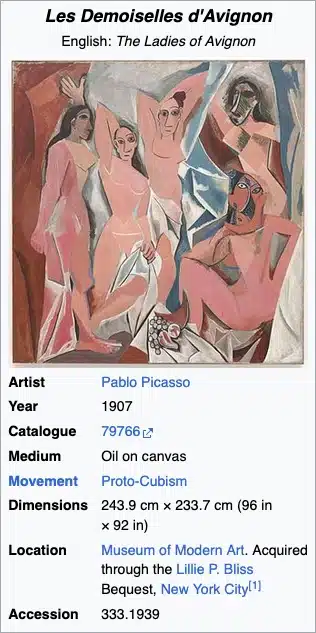
🧪 How to Verify Picasso Signatures
1️⃣ Compare with authenticated examples.
Cross-check with high-resolution images from museum archives or official catalogues.
2️⃣ Use magnification & tools.
Employ a jeweler’s loupe or microscope to check ink consistency and pressure.
3️⃣ Consult an expert.
Leading art houses (e.g., Sotheby’s, Christie’s) and authentication committees can provide professional evaluation.
4️⃣ Scientific testing.
For high-value items, chemical analysis (of ink, paper, paint) can reveal age inconsistencies.
Looking to dive deeper into the meaning and style of your own handwriting? Our advanced tool at AISIGNATOR’s Signature Analysis allows you to analyze your signature in seconds using AI technology. Whether you’re curious about your personal traits or want to compare authentic vs. forged signatures, this tool provides instant, detailed insights—perfect for collectors and handwriting enthusiasts alike.
🖌 Famous Forgery Cases Involving Picasso
- The California Print Scandal (2006): Dozens of Picasso prints with forged signatures were sold through a gallery, leading to multiple lawsuits.
- The Pierre Le Guennec Case (2010): Picasso’s former electrician claimed to possess over 200 works gifted by Picasso; many were later questioned for authenticity.
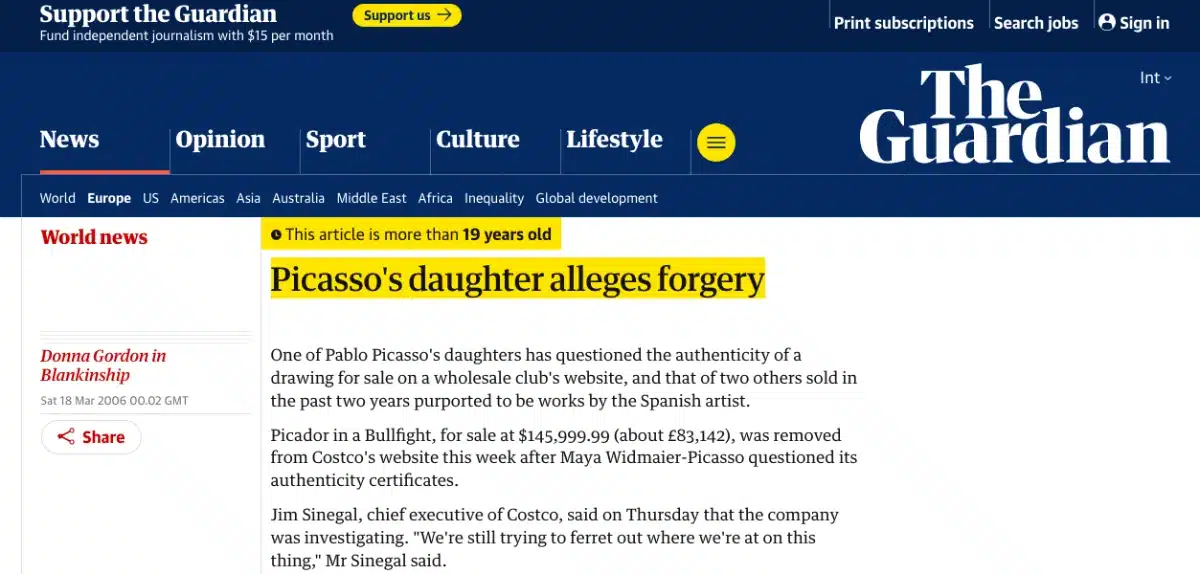
🖼 Picasso’s Most Forged Artworks
Certain iconic works are frequent targets for fake signatures:
- “Le Rêve” (1932)
- “Guernica” (1937)
- “Dove of Peace” (1949)
These pieces’ fame makes them especially tempting for fraudsters looking to profit.
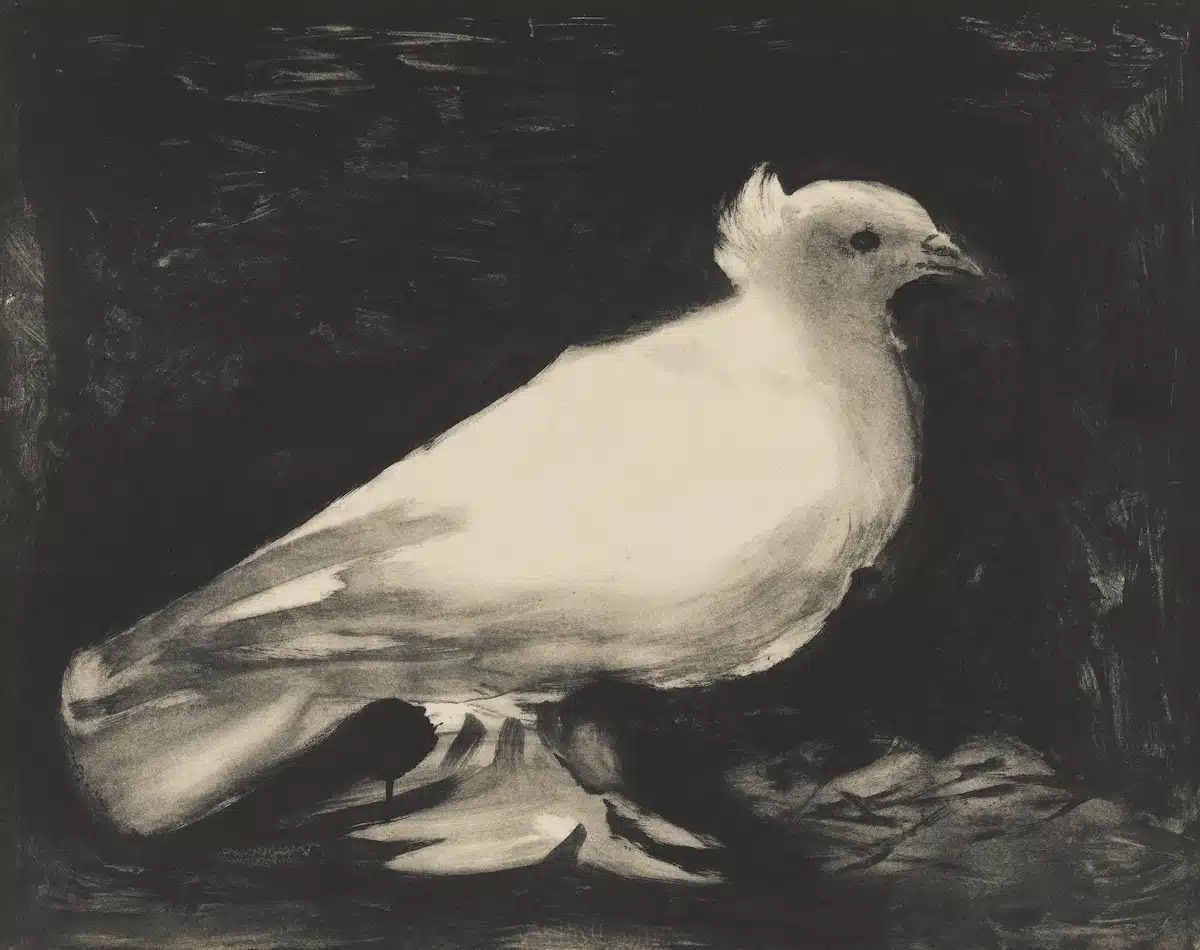
Want to combine personal identity and spiritual meaning in your signature?
Check out our Christian Signature ideas and examples for timeless inspiration.
💬 FAQs about Fake Picasso Signatures
Q1: How do I know if my Picasso is authentic?
➡️ Start by comparing your signature to verified examples, then seek professional authentication.
Q2: Are there official Picasso authentication services?
➡️ Yes, several global experts and art houses specialize in Picasso works, including the Picasso Administration in France.
Q3: Can AI tools help detect fakes?
➡️ AI analysis is advancing but should always be paired with expert human evaluation.
Q4: What’s the legal risk of owning a fake Picasso?
➡️ Owning unknowingly may not be illegal, but selling a fake as real can lead to serious legal consequences.
✍️ Want to Create Your Own Signature?
Beyond analyzing famous autographs, why not design a unique signature of your own? Try the AISIGNATOR Signature Generator—a free, AI-powered tool that lets you craft stylish, personalized signatures in seconds. Perfect for business, digital identity, or personal branding.
🚀 Try Signature Maker NowProtecting Your Collection: Mastering Fake Picasso Signature Detection
Identifying a fake Picasso signature is no small task—it requires sharp eyes, deep knowledge, and often expert intervention. But with the right tools, research, and a bit of skepticism, you can confidently protect your art investments and avoid costly mistakes. Stay vigilant, trust only verified sources, and remember: every authentic piece tells a story worth preserving.
Pro tip: Never rely solely on appearance—always demand documentation and seek expert verification before purchasing any work bearing Picasso’s name.
💡 Explore Unique Signature Ideas
- 📚 Signature Dictionary (A–Z)
- 🟢 20+ Coolest Signatures
- 🌈 10+ Billionaire Signatures
- 👨👨👦👦 50+ Famous Signature
- 🖼️ Signature Gallery
- 🌟 Best Signature Styles for My Name
- 25+ Infinity Signature Ideas & Unique Autograph Samples
- 35+ Simple Signature Ideas: Best, Easy & Minimalist Examples
- 30+ Signature Suggestions for My Name: Creative Ideas
- 💡 100+ Sample Signature Ideas

